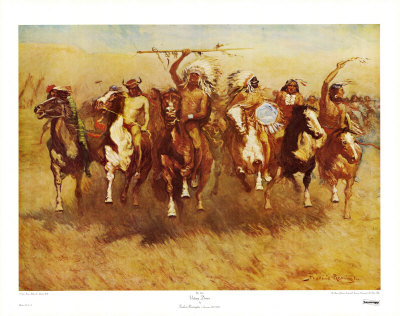The Yankton Sioux Reservation is located in the south central part of South Dakota, occupying the eastern half of Charles Mix County. The Yankton Sioux are the most populous tribe in the service unit. Although many of the Yankton refer to themselves as Dakota, they are actually a group of the Middle Sioux division also known as Nakota. There are also members of the Northern Ponca Tribe residing within the region as well as Santee Sioux.
The Yankton Service Unit provides services to the Yankton Sioux Tribe, the Santee Sioux Tribe of Nebraska, and the Northern Ponca Tribe of Nebraska. BIA estimates tribal membership at 5,700. 
Victory Dance
Buy This Art Print At AllPosters.com
Find out how you can use this image for FREE.
LOCATION
The Yankton Sioux Reservation is located in the south central part of South Dakota, occupying the eastern half of Charles Mix County. The Yankton Service Unit is comprised of six counties; Bon Homme, Charles Mix, Douglas, and Hutchinson, SD and Boyd and Knox, NE.
The Service Unit is divided into two service areas; the Santee Service Area in Knox County Nebraska which is detailed in the Tribally Operated Section of this Profile Book and the Wagner Service Area comprised of the remaining six counties. This section will profile the Wagner Service Area. Wagner, 172 miles from the Aberdeen Area Office, is the location of the Wagner Indian Health Service (IHS) Health Center.
ACCESS
State Highways, 281 and 50, provide access to the major communities within the service area. A few paved county roads exist to serve clusters of outlying communities. The Missouri River, with bridge crossings at Pickstown and Yankton, is an effective barrier to accessibility and transportation to the Wagner Health Center for major services.
Many residents in the area have access to a motorized vehicle for private transportation. The only local public transportation available is a charter air service in the Wagner community. Public bus service is available in Mitchell and major airlines in Sioux Falls.
Weather conditions sometimes affect facility access. Adverse winter weather occurs in the region causing dangerous road conditions, icy, snow packed highways, and blizzards are common. Heavy fog is sometimes a problem in the area.
TOPOGRAPHY AND CLIMATE
The reservation is mostly farm land with some small areas of timber. The remainder is rolling hills and prairie suitable for grazing. The Missouri River is the southern border of the reservation. Fort Randall Dam on the Missouri River creates Lake Francis Case which is on the southwestern part of the reservation.
The land around the lake area is high rolling hills with wooded coulees providing drainage into the lake. The climate experiences seasonal extremes of hot and cold temperatures ranging from as high as 110 in the summer to 20 F below zero in the winter. Annual average rainfall is approximately 23 inches.
HOUSING AND PUBLIC FACILITIES
Housing in the major communities are of low rent housing units, mutual help homes, and private dwellings. Wagner and Marty have senior citizen complexes for the elderly. Government housing for the Bureau of Indian Affairs (BIA) and IHS employees are available in Wagner. Rural mutual help homes are scattered around the Lake Andes area.
Wagner, typical of most small rural communities, has a limited selection of public facilities. Staple facilities such as; post office, grocery store, gas stations, churches, motels, and cafes are available. Major shopping is done in Yankton or Mitchell, SD. The smaller outlying communities usually have some type of small convenience store.
SOCIAL AND POLITICAL PROFILE
The Yankton Service Unit provides services to the Yankton Sioux Tribe, the Santee Sioux Tribe of Nebraska, and the Northern Ponca Tribe of Nebraska. The Santee Sioux Tribe of Nebraska, through tribal contract, operates the Santee Health Station which is detailed in the Tribally Operated Section of this Profile Book.
The Northern Ponca Tribe of Nebraska also operates their health programs through tribal contract; however, three of the counties included in their Contract Health Services Delivery Area (CHSDA) are located within the Yankton Service Unit. Therefore, services for these Northern Ponca residing in these counties is provided by the Yankton Service Unit.
The Yankton Sioux are the most populous tribe in the service unit. Although many of the Yankton refer to themselves as Dakota, they are actually a group of the Middle Sioux division also known as Nakota. There are also members of the Northern Ponca Tribe residing within the region as well as Santee Sioux.
The governing body of the Yankton Sioux Tribe is the Tribal Business and Claims Committee. The committee is comprised of nine elected at large members. BIA estimates tribal membership at 5,700.
In 1997, the Tribe’s environmental management staff identified an aboveground storage tank and shop floor drains release petroleum products which have contaminated the Marty Indian School Campus as the primary environmental problem facing the Tribe.